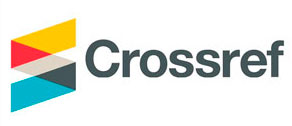Pengaruh Sistem Pengukuran Kinerja Dan Kejelasan Peran Terhadap Kinerja Karyawan
Abstract
Based on the results of the test by using partial least squares (PLS) SPK known that directly influence the performance of employees and indirectly through role clarity. In addition to seeing how the indirect effect of role clarity on the relationship between the SPK and the performance of employees, the authors conducted a track test. Based on the test track using Sobel's test found that SPK relations and employee performance is influenced by factors mediating role clarity.
Keywords
Full Text:
PDFReferences
Abramis, D. J. (1994) Work role ambiguity, job satisfaction, and job performance: meta-analyses and review. Psycological Reports, 75, 1411 - 1433
Al-Gahtani, S. S., Hubona, G. S., & Wang, J. 2007. Information technology (IT) in Saudi Arabia: Culture and the acceptance and use of IT. Information & Management, 44(8): 681-691.
Auzair, S. M., and K. Langfield-Smith. 2005. The effect of service process type, business strategy and life cycle stage on bureaucratic MCS in service organizations. Management Accounting Research 16 (4):399-421.
Baines, A., and K. Langfield-Smith. 2003. Antecedents to management accounting change: a structural equation approach. Accounting, Organizations and Society 28 (7-8):675-698
Binnewies, C., S. Ohly, and C. Niessen. 2008. Age and creativity at work. Journal of Managerial Psychology 23 (4):438-457.
Bititci, Umit S., Allan S. Carrie and Liam McDevitt, Integrated performance
measurement systems: a development guide. University of Strathclyde, Glasgow, UK. International Journal of Operations & Production Management, Vol. 17 No. 5, 1997, pp. 522-534.
Burney, L. L., Henle, C. A., & Widener, S. K. 2009. A path model examining the relations among strategic performance measurement system characteristics, organizational justice, and extra- and in-role performance. Accounting, Organizations and Society, 34(3-4): 305-321.
Camison, C., & Lopez, (2010). ―An examination of the relationship between manufacturing, flexibility and firm performance: The mediating role of innovation.‖ International Journal of Operations & Production Management, 30 (8) : 853 - 878
Chenhall, R. H. 2003. Management control systems design within its organizational context: findings from contingency-based research and directions for the future. Accounting, Organizations and Society 28 (2-3):127-168.
———. 2005. Integrative strategic performance measurement systems, strategic alignment of manufacturing, learning and strategic outcomes: an exploratory study. Accounting, Organizations and Society 30 (5):395-422.
Collier, P., and A. Gregory. 1995a. Investment appraisal in service industries: a field study analysis of the U.K. hotels sector. Management Accounting Research 6 (1):33-57.
———. 1995b. Strategic management accounting: a UK hotel sector case study. International Journal of Contemporary Hospitality Management 7:16-21.
Falk, R. Frank & Nancy B. Miller. 1992. A primer for soft modeling. Akron: University of Akron
Fornell, C., & Bookstein, F. 1982. Two structural equation models: LISREL and PLS applied to consumer exit-voice theory. Journal of Marketing Research, 19: 440-452.
Gomes, C. F. 2010. Assessing operational effectiveness in healthcare organizations: a systematic approach. International journal of health care quality assurance 23 (2):127.
Goodale, J. C., D. F. Kuratko, and J. S. Hornsby. 2008. Influence factors for operational control and compensation in professional service firms. Journal of Operations Management 26 (5):669-688.
Hall, M. 2008. The effect of comprehensive performance measurement systems on role clarity, psychological empowerment and managerial performance. Accounting, Organizations and Society, 33(2-3): 141-163.
Hulland, J. 1999. Use of partial least squares (PLS) in strategic management research: a review of four recent studies. Strategic Management Journal, 20(2): 195-204.
Jackson , S. E., & Schuler R. S. (1985) A meta analysis and conceptual critique of research on role ambiguity and role conflict in work setting. Organizational Behavior and Human Decision Processes, 36, 16 - 78.
Kaplan, R. S., and D. P. Norton. 1996. The Balanced Scorecard: Translating Strategy into Action Boston, MA: Harvard Business School Press.
Kihn, L.-A. 2010. Performance outcomes in empirical management accounting research: Recent developments and implications for future research. International Journal of Productivity and Performance Management 59 (5):468-492.
Lawler, E. E. (1992) The ultimate advantage: creating the high involvement organization. San Francisco: Jossey-Bass
McClelland, D. C., Personality (New York: Holt, Rinehart & Winston, 1967).
Robbins, Stephen., P., Timothy A Judge. 2007., Perilaku Organisasi, Salemba Empat, Jakarta
Sawyer, J.E. (1992) Goal and process clarity: specification of multiple constructs of role ambiguity and a structural equation model of their antecedents and consequences. Journal of Applied Psycology, 77 : 130 - 142
Shields, M. D. 1997. Research in Management Accounting by North Americans in the 1990s. Journal of Management Accounting Research 9:3-61.
Spohrer, J., and P. P. Maglio. 2008. The Emergence of Service Science: Toward Systematic Service Innovations to Accelerate Co-Creation of Value. Production & Operations Management 17 (3):238-246.
Spreitzer, G. M. 1995. Psychological empowerment in the workplace: dimensions, measurement, and validation. Academy of Management Journal, 38(5): 1442-1465.
_________________, Kizilos, M. A., & Nason, S. W. 1997. A dimensional analysis of the relationship between psychological empowerment and effectiveness, satisfaction and strain. Journal of Management, 23(5): 679-704.
Urbach, N., and F. Ahlemann. 2010. Structural equation modeling in information systems research using partial least squares. Journal of information Technology Theory and Application 11 (2):5-39.
DOI: http://dx.doi.org/10.36448/jak.v4i2.417











